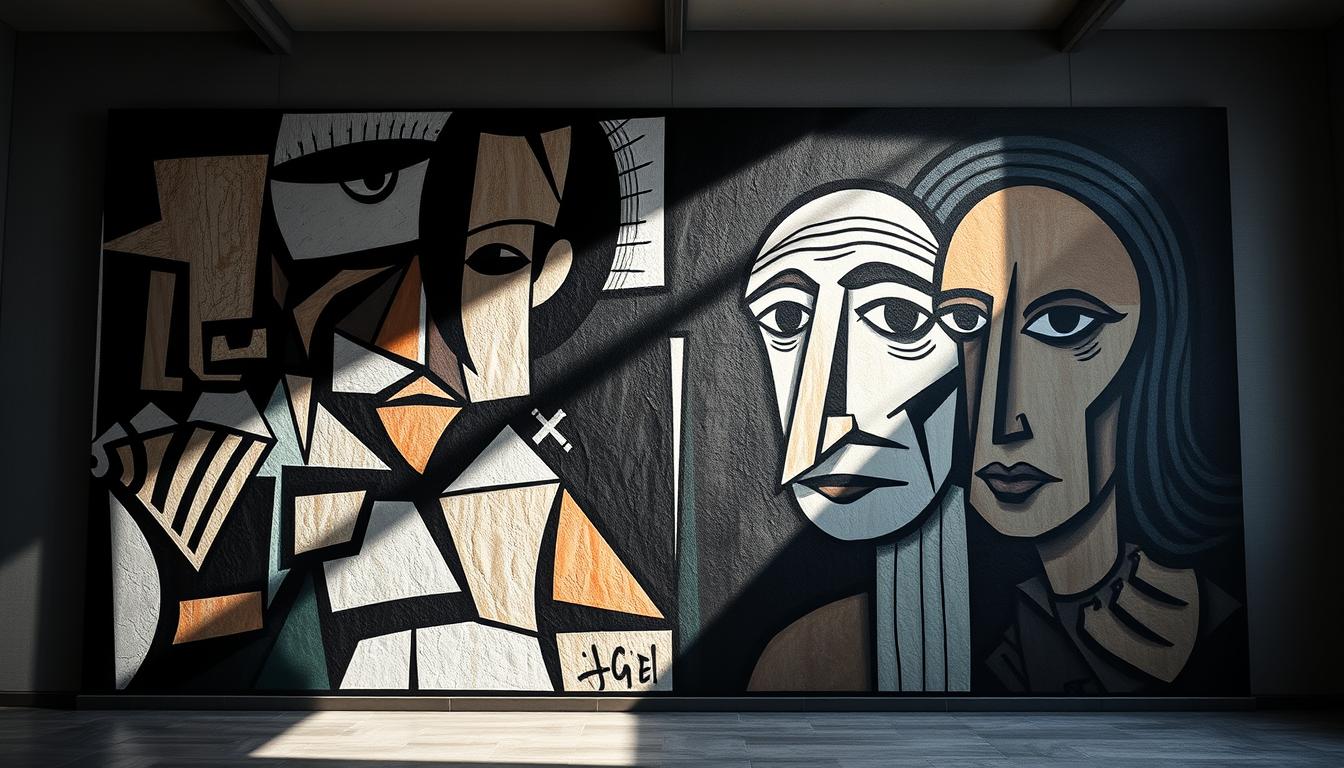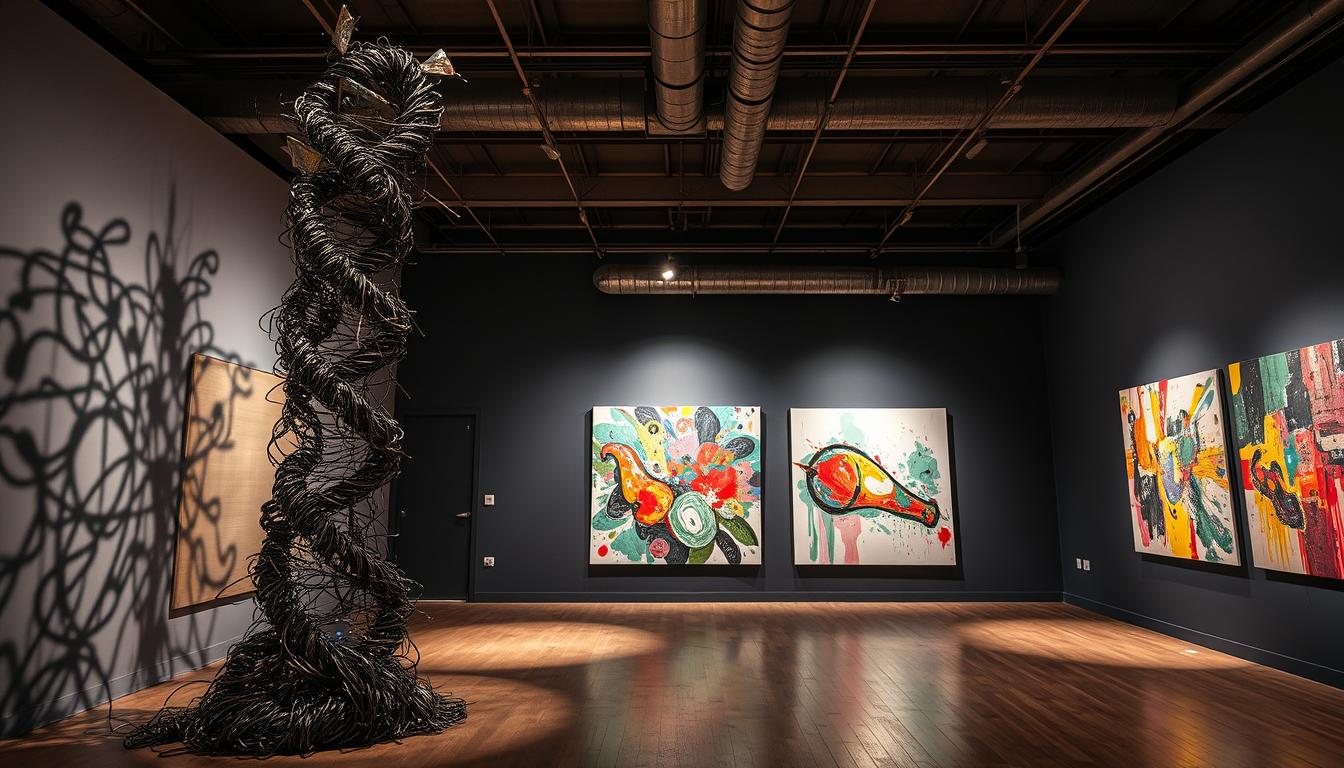Can a single canvas claim the crown for a life that changed painting forever? This question opens a debate that mixes museum fame, cultural impact, and the shifting currents of art history.
Pablo Picasso pushed boundaries from the Blue Period through Cubism and beyond. His career reshaped modern art and the visual culture of the world. No single work can capture that full arc.

We will compare leading candidates like Guernica and Les Demoiselles d’Avignon, and show how each period paved the way for seismic breakthroughs. Expect concise snapshots with dates, locations, and what to look for in composition.
For a deeper list of notable paintings and museum locations, see this short guide on famous paintings by pablo picasso.
Fame blends critical acclaim and cultural memory, so our goal is to show how certain works became shorthand for an era and for Picasso’s lasting work.
Key Takeaways
- Multiple masterpieces compete as signature pieces in modern art.
- Pablo Picasso’s career spans many periods that reshaped art history.
- Museum visibility and cultural impact shape a painting’s fame.
- Guernica and Les Demoiselles d’Avignon are recurring contenders.
- Each work belongs to a continuous arc of experimentation.
- The guide presents factual, museum-friendly snapshots for readers.
Picasso, abstraction, and the making of a modern art icon
Early moods and distant masks fed a restless search that remade painting. In his early years, pablo picasso moved from the Blue Period’s cool melancholy into the warmer Rose stage. Those shifts set a tone for later experiments.
He absorbed African and Iberian motifs and studied Cézanne’s planes. Then he translated those influences into a new language for modern art. The Old Guitarist and La Vie show mood and vulnerability that evolved into structural play.
"Each period added tools to his visual vocabulary, turning private experiments into a public movement."
Collaboration with Georges Braque turned breakthroughs into a sustained direction. Cubism and collage reworked form, space, and time, making his work central to twentieth-century art history.
- Touchpoints: The Old Guitarist (mood), Les Demoiselles (mask influence), Still Life with Chair Caning (collage).
- Outcome: Abstraction ranged from simplified figures to full deconstruction.
| Period | Key Work | Characteristic | Museum |
|---|---|---|---|
| Blue Period | The Old Guitarist | Melancholic palette, human vulnerability | Art Institute of Chicago |
| Proto-Cubism | Les Demoiselles d’Avignon | African masks, fractured figures | MoMA |
| Cubism & Collage | Still Life with Chair Caning | Geometric reduction, material play | Musée Picasso |
What is Picasso's most famous abstract art?
When measuring influence, two paintings repeatedly surface as contenders for Picasso's signature achievements. This short section lays out the head-to-head and explains how "fame" gets counted in museums and classrooms.
Two frontrunners: a lightning bolt vs. an epoch-defining canvas
Les Demoiselles (Les Demoiselles d'Avignon, 1907, MoMA) reads like a formal revolution. Sharp planes, mask-like faces, and fractured figures changed how artists handled space and form on the painting surface.
Guernica (1937, Museo Reina Sofía) answers with scale and moral force. The bleak palette, the monumental canvas, and anguished figure placement tied the work directly to the spanish civil war and to debates about civilian suffering in war.
How "fame" is measured: museums, impact, and memory
"A work becomes shorthand when it lives in major museums, textbooks, and daily culture."
Places like MoMA and Museo Reina Sofía, wide reproduction, and classroom use shape which pieces appear as picasso famous reference points. Girl (Girl before a Mirror) keeps Surrealist vocabulary visible in pop culture and schooling.
- Demoiselles scores for formal innovation and the rupture of traditional figure treatment.
- Guernica dominates on political resonance and global cultural memory.
Conclusion: Both works are staples of modern art. If you value radical change in form, Demoiselles may lead. For moral urgency and public memory, Guernica often edges ahead. Weigh your own criteria when choosing which work tops your list of lasting works.
From Blue to Pink: setting the stage for abstraction
Early paintings from the Blue era reveal how mood and economy of form guided later innovation.
The Old Guitarist (1903), Art Institute of Chicago — Blue Period mood and form
The Old Guitarist (1903) at the art institute chicago uses a narrow palette and long, bowed pose. The elongated figure creates a somber, human presence that still feels immediate.
Simplified forms and limited color show how painting could carry emotion without detail. This restraint hinted at future structural experiments while keeping the human subject central.
La Vie (1903) — symbolism, grief, and early simplification
La Vie pares narrative down to a few charged elements. Symbols of life and love sit in a cool, spare scene that reads like an essentials-only composition.
These two paintings turned grief and survival into a working style. Museum display at the institute chicago keeps them as entry points for new viewers.
"Simplification became a technique, not just a mood."
- Early loss and close observation shaped visual choices.
- Reduction of detail prepared Picasso to reshape figures and structure.
For more concise facts on his early trajectory, see the ultimate guide to Picasso.
Proto-Cubism arrives: Les Demoiselles d’Avignon changes everything
The 1907 canvas acts as a hinge between tradition and a new visual language. It rejected flattering illusion and insisted on structural truth.
Mask influence and geometric forms in figures
Les Demoiselles fused African mask motifs with fractured bodies. Faces become faces-as-mask, and bodies break into geometric shapes.
The picture destabilized perspective. The picture plane reads like a stage where figures overlap and collide, not recede into depth.
MoMA’s role in canonizing modern milestones
MoMA's acquisition placed the canvas at the center of the museum modern art story. Generations learned the new style through that display.
The painting's aggression and deliberate distortion pushed peers toward analytic composition. Its fame grew from both radical internal logic and institutional visibility.
| Feature | Effect | Historical link | Museum |
|---|---|---|---|
| Mask-like faces | Dehumanize then reveal structure | Cultural influence from Africa | MoMA |
| Planar facets | Flattened space | Cézanne’s late work | MoMA |
| Distortion | New viewing method | Proto-Cubist movement | MoMA |
"The canvas remains both revelation and provocation."
For a focused reference, see Les Demoiselles d'Avignon. The piece keeps teaching viewers how to look.
Cubism and collage: reducing forms to geometric shapes
Cubism turned pictured space into a patchwork of viewpoints, forcing viewers to reassemble scenes.
This phase cut subjects into planar fragments and favored muted tones early on. Over time, it moved from analysis toward assembly.
Analytic to Synthetic: evolution in style and palette
Analytic Cubism broke objects into small, fractured facets and used a restrained palette. Viewers read many angles at once rather than a single perspective.
Synthetic Cubism brightened tones and introduced composed elements. Artists began to reapply earlier fragments into new, clearer shapes.
Still Life with Chair Caning (1912), Musée Picasso — the birth of collage
Still Life with Chair Caning pushed the limits of what a canvas could contain. Picasso added oilcloth and a rope edge to claim everyday material as high art.
"Everyday fragments entered the painting as signs of modern life."
The movement’s legacy with Braque and beyond
Picasso and Georges Braque traded ideas rapidly, so innovation spread fast through their circle. Collage and the logic of facets changed how figures and objects read in later works.
By compressing space and time into a single surface, Cubism rewrote the grammar of painting. Museums in picasso paris and beyond now preserve this laboratory of invention.
For a plain primer on the method and history, see Cubism overview at Tate.
Surrealism, muses, and the language of distorted figures
In the early 1930s Picasso turned inward, translating private passion into a new visual vocabulary. Intimacy, dreams, and political tension shaped a string of portraits and lyrical experiments.

Le Rêve (1932) — Marie-Thérèse Walter and biomorphic curves
Le Rêve and nearby paintings show how marie-thérèse walter softened contours and brightened the palette.
Voluptuous, biomorphic curves rework the human figure into flowing, dreamlike forms. The muse pushed the artist toward sensual, playful surfaces.
Girl before a Mirror (1932), MoMA — identity split across time
The girl before a mirror confronts a doubled self across a split surface. Color and mirrored motifs stage a private meditation on age, desire, and identity.
MoMA’s display keeps this phase visible in public conversation.
Portrait of Dora Maar (1937) — fractured portraiture and emotion
dora maar appears in jagged, dislocated planes. Sharp angles and interruption read as psychic strain rather than gentle lyricism.
"Surrealist ideas let the unconscious redraw the human face."
| Work | Muse | Key trait | Museum |
|---|---|---|---|
| Le Rêve (1932) | marie-thérèse walter | Biomorphic curves, warm palette | Private collection |
| Girl before a Mirror (1932) | marie-thérèse walter | Split identity, bold color | MoMA |
| Portrait of Dora Maar (1937) | dora maar | Fractured visage, tension | Musée Picasso |
Surrealist frameworks let figures move between lyric and jagged vocabularies. These paintings link private intimacy to public statement and help prepare the visual grammar that leads into larger political canvases.
War and witness: Guernica and its echoes
Picasso’s response to bombing and loss reframed the role of the painter. In 1937 he turned private practice into public testimony during the spanish civil war.
Guernica (1937), Museo Reina Sofía — Spanish Civil War on canvas
Guernica fills a monumental canvas with compressed battlefield symbols: lamps, bulls, horses, and shattered figures.
Its black, white, and gray palette echoes news photography and gives the painting a documentary urgency. Created in response to the bombing, it became a global emblem against civil war atrocities and entered the wider world conscience.
The Weeping Woman (1937), Tate Modern — grief as a modern icon
The Weeping Woman acts as an intimate counterpart. This piercing portrait distills collective anguish into a single, repeated face.
dora maar figures here as muse and subject, her features turned into a shorthand for suffering. In his 1937 picasso work, Cubist fracture meets Surrealist drama to witness and condemn war.
"These works balance chaos with structure so the message reads instantly."
Guernica’s fame rests on artistic invention and undeniable moral force; the enduring moral work keeps it visible in classrooms, protests, and publications.
Late works and enduring symbols
In later decades the artist chose economy over excess, turning long inquiry into clear, immediate signs.
Dove (1949) — peace simplified into universal form
The 1949 dove reduces a complex hope into a single, calm silhouette. Its clean outline made the image easy to reproduce on posters and pins after World War II.
Why it resonated: In a time of rebuilding, the dove became a quick signal of peace that crossed language and borders. The figure worked as both symbol and slogan.
Don Quixote (1955) — line, legend, and late-style minimalism
Don Quixote pares Cervantes’ tale to a few decisive strokes. With minimal line the scene conjures horse, lance, and motion.
Why it matters: The drawing shows how late-career evolution favored speed and clarity. A few marks now carry narrative, myth, and personality.
"Simplicity, when earned, can be as radical as revolution."
| Work | Date | Key Trait | Public Reach |
|---|---|---|---|
| Dove | 1949 | Emblematic silhouette, peace symbol | Widespread prints, posters, peace movements |
| Don Quixote | 1955 | Economy of line, narrative suggestion | Reproductions, book illustrations, exhibitions |
| Late style overall | 1940s–1960s | Speed, clarity, distilled form | Global recognition, educational use |

- Late works compress decades of study into a spare, confident hand.
- Time and life shaped a style where the figure reads as idea as much as body.
- Affection, memory, and literary love informed subject choices.
- These images remain popular in prints and posters, proving broad appeal.
Conclusion: The late period shows that simplicity, earned by evolution and experience, can be a lasting and radical statement.
Where to see Picasso’s most famous works
Seeing key canvases in person changes how you read scale, color, and fracture. Plan visits to major institutions to connect studio experiments, political statements, and late simplifications.
Museum of Modern Art, New York
Stand before les demoiselles to feel the proto-Cubist jolt. Then compare that energy to the psychological play in Girl before a Mirror.
Museo Reina Sofía, Madrid
Guernica’s panoramic canvas (349 × 776 cm) reworks scale and sorrow. The gallery setting amplifies its political charge.
Art Institute of Chicago
At the art institute see The Old Guitarist, a Blue Period touchstone of mood and restraint.
Tate Modern, London
The Weeping woman concentrates national grief into a single fractured face.
| City | Key Work | Why Visit |
|---|---|---|
| New York (MoMA) | Les Demoiselles d'Avignon; Girl before a Mirror | Compare formal revolution and psychological portraiture |
| Madrid (Museo Reina Sofía) | Guernica | Experience monumental scale and political witness |
| Chicago (Art Institute) | The Old Guitarist | See Blue Period mood and pared form |
| London (Tate Modern) | The Weeping Woman | Study emotional fragmentation in a single visage |
"Use museum labels and sightlines to spot motifs across paintings and to follow Picasso’s evolution."
- Add Musée Picasso, Paris to view Portrait of dora maar and Still Life with Chair Caning for studio context.
- If travel is limited, explore high-resolution museum sites to study brushwork and collage textures.
Conclusion
In the end, Picasso’s legacy reads like a conversation between formal invention and moral witness. Guernica often leads for moral weight while Les Demoiselles d'Avignon wins for formal shock. That tension helps explain why a single picasso famous painting never tells the whole story.
Across time his pablo picasso evolution moved from Blue mood to Cubism to Surrealist portraits. Muses such as marie-thérèse walter and dora maar shaped palette, portrait, and feeling.
See these paintings in person when you can; scale, figures, and canvas presence change perception. Fame blends museum stewardship, cultural storytelling, and invention. Pick the criteria that matter to you and decide which picasso work stays with you longest.
Enhance Your Space with Unique Modern Masterpieces
Are you inspired by the innovative mediums and conceptual depth highlighted in our exploration of contemporary art? You’re not alone! Today’s art enthusiasts are seeking cultural relevance and emotional connections in their artwork. However, finding pieces that resonate with modern themes and fit your unique style can be a challenge. That’s where we come in!
At Rossetti Art, we specialize in canvas prints, original paintings, and modern sculptures that celebrate the spirit of now. Each piece created by Chiara Rossetti brings a personal touch that connects deeply with current social narratives—just like the modern masterpieces discussed in the article. Don’t miss out on the chance to elevate your home decor with breathtaking artwork that speaks to your values and aesthetic. Explore our collection today and find your perfect piece! Act now, and transform your space into a gallery of inspiration!
FAQ
What are the leading candidates for Picasso’s landmark abstract works?
Two standout works often lead discussions: Les Demoiselles d’Avignon, which launched proto‑Cubism with fractured planes and mask‑inspired faces; and Guernica, a vast political mural that transformed modern painting into witness and protest.
How did early periods like the Blue and Rose set the stage for later abstraction?
The Blue Period, with works such as The Old Guitarist, pared down form and mood, while La Vie introduced symbolic simplification. These phases sharpened Picasso’s focus on emotional economy, preparing him to break figures into geometric parts.
Why is Les Demoiselles d’Avignon seen as a turning point?
The painting shattered Renaissance perspective and blended African and Iberian mask influences into angular, flattened figures. It paved the way for Cubism and forced viewers to rethink representation and space.
What role did collage and Cubism play in reducing forms to geometry?
Cubism moved from analytic deconstruction to synthetic reconstruction. Works like Still Life with Chair Caning introduced collage, literal fragments of reality, and emphasized planes, texture, and new palettes.
How did Surrealism and Picasso’s muses reshape his approach to distorted figures?
Figures became biomorphic and psychologically charged. Paintings such as Le Rêve and Girl before a Mirror explore inner life through curved forms and mirrored identities, while portraits of Dora Maar amplify emotional fracture.
What makes Guernica a defining modern art icon beyond its subject?
Guernica combines monumental scale, stark monochrome, and symbolic imagery to document the Spanish Civil War’s horrors. Its public power, exhibition history, and political resonance cemented its global cultural impact.
Which later works show Picasso’s simplified, near‑minimal language?
Postwar pieces such as Dove and the 1955 Don Quixote etching distill image to essential line and symbol, reflecting a late style that favors clarity, gesture, and universal motifs like peace and myth.
Where can major Picasso works be seen today?
Key locations include the Museum of Modern Art in New York for Les Demoiselles d’Avignon and Girl before a Mirror; Museo Reina Sofía in Madrid for Guernica; the Art Institute of Chicago for The Old Guitarist; and Tate Modern for The Weeping Woman.
How should one measure a work’s fame: museums, influence, or cultural memory?
Fame mixes museum visibility, art‑historical impact, and public recognition. A painting like Guernica scores highly in all three, while Les Demoiselles d’Avignon ranks for revolutionary influence and scholarly attention.






Leave a comment
This site is protected by hCaptcha and the hCaptcha Privacy Policy and Terms of Service apply.